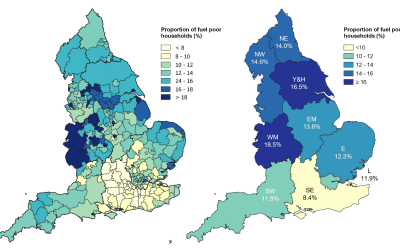Although fuel poverty is defined and measured slightly differently across the UK, it is typically associated with families from the lower economic spectrum that are financially challenged by the utilities costs that are expended on warming the home.
In England, families that find themselves with residual incomes below the poverty threshold after covering the fuel expenses, or, experience fuel costs that are above the national median level, are considered to suffer from fuel poverty, according to the Low-Income High Cost (LIHC) metric.
In Scotland, households that experience fuel poverty are those whose utilities costs are above 10% than the households adjusted income. For households receiving social benefits and find themselves without enough financial resources to maintain an “acceptable standard of living” after covering the fuel expenses, are also considered to be experiencing fuel poverty.
Similar criteria are present also in Wales, where the 10% rules also apply but moreover, when families spend more than 20% of their household income on fuelling their home, they are classified as being in severe fuel poverty.

Risks and Main Contributing Factors
There are various factors contribute to fuel poverty, some that involve the individual or household, whilst some relate to the house or property itself. Risk factors associated with individual households can involve things such as: low income, unemployment, high fuel costs, fuel payment methods, young age (16-25), senior age (65+) and individuals with medical conditions.
Property related risk factors could be the age, size and state of repair of the property. The quality and amount of insulation in the property. The properties construction type and the efficiency of it’s heating system as well as type of tenure can also have a significant impact on fuel poverty in the household.

Statistics & Demographics
In 2018, England reported that 2.4 million (10.3%) of its households are classified as fuel poor, whilst Scotland and Wales identified 619,000 and 155,000 households, respectively, that experience fuel poverty. In the West Midlands alone, households classified as fuel poor are well in excess of 300,000.
Furthermore, the current pandemic is likely to have increased these figures further across the country.
Typical Characteristics of Fuel Poverty
What you may hear:
- Home is usually too cold/ draughty.
- The householders have respiratory problems.
- The fuel bills are too high.
- They are getting into fuel debt.
- The householders stay in bed to keep warm.
- The householder/s may wish to stay in hospital because it is more comfortable.
- They have moved over to a prepayment meter to avoid incurring debt.
What you may feel:
- Cold.
- Large differences in temperatures between rooms.
- Your hands might be cold to the touch.
- You might smell Damp.
- Sense of gloom and a depressed atmosphere.
What you may see:
- Children constantly have runny noses, rashes, ear infections, conjunctivitis.
- Children often off school.
- Children are emotional/ tired.
- Mould stains on walls or curtains.
- Peeling wallpaper or paint.
- Ventilation points blocked.
- Householder wearing too much clothing.
What you may notice about the heating:
- Portable bottled gas heaters.
- Partial or no fixed heating system.
- Heating controls absent / not working / switchedoff.
- Visual evidence that heating appliances are not in use.

Health Implications
Fuel poverty can have a diverse set of health implications depending on either household temperature or the cleanliness of the household.
Cold Weather Plan for England have suggested that low indoor temperature present a range of health-related risks caused by fuel poverty such as: heart attacks/strokes, respiratory disease, influenza, worsening of existing health conditions or slower recoveries, falls/injuries, hypothermia, development of mental health illnesses, carbon monoxide poisoning, poorer nutrition.
To avoid such risks, homes should be kept at a temperature of 18*C-24*C (64*F-75*F). Home temperatures that drop below 16*C (61*F) present diminished resistance to respiratory infections. When temperatures are below 12*C (54*F) they affect body temperatures and increase blood pressure and viscosity, whereas when homes are warmed at bellow 5*C (41*F), a significant risk of hypothermia is present.
In terms of damp and mould in the household, they can enhance the risk of respiratory infections, runny nose, itchy eyes, cough, rhinitis, as well as reducing the resistance to bacteria and viruses.
Summary
Although there are various factors that contribute to fuel poverty, the three main causes that would also require the most attention are the high costs of fuel, low income, but also poor energy efficiency. It is the combination of these factors that place various householders in difficult conditions and lead to physical and mental health problems.
Potential Solutions
In an attempt to understand and help overcome factors that can cause fuel poverty, a series of solutions and ideas have been initialised by the British Government, as well as other (non-profit) organisations, such as Warmer Homes West Midlands.
Several of these solutions are listed below:
West Midlands has highest rates of fuel poverty in England
You might be wondering why you paying more for your energy?
Simple answer: The energy price cap increased. On the first of April this year the energy price cap increased by 54%. What is a price cap?
Changes announced to energy support packages
You might be wondering why you paying more for your energy?
Simple answer: The energy price cap increased. On the first of April this year the energy price cap increased by 54%. What is a price cap?
Government Support for Household Energy Bills
What does Government offer to help with rising energy costs?





After looking at a handful of the articles on your site, I seriously like your way of writing a blog. I saved it to my bookmark webpage list and will be checking back soon. Take a look at my web site too and let me know what you think.
excellent points altogether, you simply gained a new
reader. What could you suggest in regards to your publish that you just made a few days ago?
Any certain?
Feel free to visit my webpage; tracfone 2022